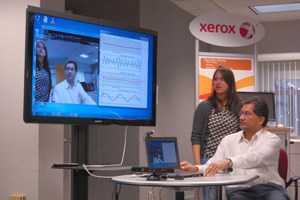Feb 7 2014
Chronic illnesses such as cardiovascular and respiratory diseases require continuous monitoring, which can be expensive and difficult, especially in remote areas and homes. The Xerox Innovation Group today announced a suite of healthcare research projects being conducted in India by Xerox Research Centre India (XRCI) and Xerox Research Center Webster (XRCW) in New York that use video cameras and data analytics to monitor a patient's condition without wires, discomfort or risk of infection.
 Lalit K. Mestha, Xerox research Fellow, and Survi Kyal, Xerox research engineer, demonstrate how a simple webcam can pick up health vitals such as heart and respiration rates at the Xerox Research Center Webster. The team is piloting the remote healthcare system at hospitals in New York and Manipal, India. (CNW Group/Xerox Canada)
Lalit K. Mestha, Xerox research Fellow, and Survi Kyal, Xerox research engineer, demonstrate how a simple webcam can pick up health vitals such as heart and respiration rates at the Xerox Research Center Webster. The team is piloting the remote healthcare system at hospitals in New York and Manipal, India. (CNW Group/Xerox Canada)
Scientists believe the contact-free approach will make it less intrusive to patients in India and across the globe for doctors to monitor the condition of their patients.
Working closely with the Manipal University Hospital in Manipal, India, Xerox researchers have been testing the feasibility of using video cameras to develop technologies that continuously monitor the condition of patients. Using patented software algorithms, Xerox scientists have been able to convert data collected by the cameras into vital signs. When a heart pumps, for example, freshly oxygenated blood makes the skin appear redder. A video camera documents these subtle changes that are imperceptible to the human eye, and a computer then calculates a heart rate. Because the cameras can scan skin from a distance, patients can - in theory - be free from wires, sensors and other devices that typically are used today.
"Our initial work at Manipal was in the neonatal unit, evaluating the algorithms to monitor infant vital signs with cameras, but that has quickly expanded into other areas," said Lalit Mestha, research fellow at the Xerox research center in New York and project leader.
Using cameras to track a patient's condition can improve comfort levels and decrease the risk of infection. Cameras can open up the possibility of diagnosing patients at their homes, clinics and in locations that may be far from a specialist.
Mestha's team also is working with the University of Rochester Medical Center in New York on a project that uses cameras to detect occurrence of atrial fibrillation, a condition that can increase a person's risk of stroke by a factor of five.
Research conducted in hospital rooms provides Xerox scientists with a first-hand view of the medical field through interaction with practitioners and patients.
"Our partnership with Manipal University Hospital is helping us move the technology closer to reality," said Manish Gupta, Xerox vice president and director of XRCI. "This research can have great implications for the future of healthcare and telemedicine in India and across the globe."